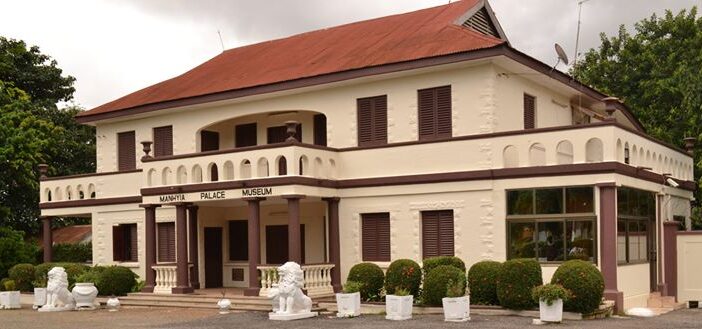The Manhyia museum, the very hallmark of the war of the golden stool used to be the Palace of the Asantehene. The Manhyia (Akan language meaning Oman hyia – gathering of the people) Palace is the seat of the Asantehene of Asanteman, as well as his official residence. It is located at Kumasi, the capital of the Ashanti Region.
The palace was built in 1925 by the British some time after the Third Anglo-Ashanti War in 1874( the war of the golden stool), when the British had destroyed the original palace built by the Asantes. The British were said to have been impressed by the size of the original palace and the scope of its contents, which included “rows of books in many languages.”, but due to events in the War of the Golden Stool, the British demolished the royal palace with explosives.
Upon the return of the Asantehene Nana Prempeh I from exile in the Seychelles Islands, the building was offered to him for use as his residence. This was because prior to the Asantehene’s exile, his old palace had been burnt down in the Yaa Asantewaa War.
The war was fought between the British and the Asantes because of the refusal of the Asantehene to offer the Golden stool to the then governor of the Gold Coast. Prempeh I only accepted the offer after he had paid for the cost of the building in full.
The Anglo-Ashanti Wars from which as a result of the third, the palace became a monument of beautiful history, were a series of five 19th-century conflicts that took place between 1824 and 1900, between the Ashanti Empire—in the Akan interior of the Gold Coast—and Great Britain and its allies.
The British lost and negotiated truces in several of these wars, with the final war resulting in British burning of Kumasi and official occupation of the Ashanti Empire in 1900. The wars were mainly due to Ashanti attempts to establish a stronghold over the coastal areas of present-day Ghana. Coastal peoples such as the Fantes and the Gas came to rely on British protection against Ashanti incursions
The Third Anglo-Ashanti War, also known as the “First Ashanti Expedition”, lasted from 1873 to 1874. In 1869, a German missionary family and a Swiss missionary had been taken from Togo to Kumasi. They were still being held in 1873.
The British Gold Coast was formally established in 1867 and in 1872, Britain expanded their territory when they purchased the Dutch Gold Coast from the Dutch, including Elmina which was claimed by the Ashanti.
The Dutch had signed the Treaty of Butre in 1656 with the Ahanta. The treaty’s arrangements proved very stable and regulated Dutch-Ahanta diplomatic affairs for more than 213 years. This all changed with the sale of the Dutch Gold Coast. The Ashanti invaded the new British protectorate.
General Garnet Wolseley was sent against the Ashanti with 2,500 British troops and several thousand West Indian and African troops (including some Fante) and subsequently became a household name in Britain. The war was covered by war correspondents, including Henry Morton Stanley and G. A. Henty. Military and medical instructions were printed for the troops.[10] The British government refused appeals to interfere with British arms manufacturers who sold to both sides.
The golden stool that incited this third Anglo war, long symbolized governing power for the Ashanti people.
The Golden Stool (Ashanti-Twi: Sika dwa; full title, Sika Dwa Kofi “the Golden Stool born on a Friday”) is the royal and divine throne of kings of the Ashanti people and the ultimate symbol of power in Asante. According to legend, Okomfo Anokye, High Priest and one of the two chief founders of the Asante Confederacy, caused the stool to descend from the sky and land on the lap of the first Asante king, Osei Tutu.[2] Such seats were traditionally symbolic of a chieftain’s leadership, but the Golden Stool is believed to house the spirit[3] of the Asante nation—living, dead and yet to be dead.
Each stool is understood to be the seat of the owner’s soul and when not in use it is placed against a wall so that other souls passing by may relax on it. The Golden Stool is the royal throne and must never touch the ground; instead it is placed on a blanket. During inauguration, a new king is raised and lowered over the stool without touching it.[5] The Golden Stool is carried to the king on a pillow, as only the Asantehene himself is allowed to handle it. During solemn occasions, the Golden Stool is placed on the king’s left on a throne of its own, the hwedom dwa (Ashanti, throne facing the crowd
Below is a sample of the letter written to the Ashantis during the war:
“On March 19, 1901, British statesman David Lloyd George stated in a Parliamentary session that: “Frederick Hodgson’s quest of the Golden Stool was something like the quest of the Holy Grail”. The Member of Parliament of Caernarfon as well as other members of the House were extremely concerned about the huge expense that the House was being made to pay for the war. Joseph Chamberlain, the then Secretary for the Colonial Office, was questioned extensively as to whether or not Frederick Hodgson had actually been given prior permission to demand the Golden Stool from the Asante people, because he seemed to think that; “if he could only get possession of the Golden Stool he would be able to govern the country for all time”.
Hodgson advanced toward Kumasi with a small force of British soldiers and local levies, arriving on the 25 March 1900. Hodgson, as representative of a powerful nation himself, was accorded traditional honors upon entering the city with children singing “God Save the Queen” to Lady Hodgson.[8] After ascending a platform, he made a speech to the assembled Ashanti leaders. The speech, or the closest surviving account that comes through an Ashanti translator, reportedly read:[9][better source needed]
Your King Prempeh I is in exile and will not return to Ashanti. His power and authority will be taken over by the Representative of the Queen of Britain. The terms of the 1874 Peace Treaty of Fomena, which required you to pay for the cost of the 1874 war, have not been forgotten. You have to pay with interest the sum of £160,000 a year. Then there is the matter of the Golden Stool of Ashanti. The Queen is entitled to the stool; she must receive it.
Where is the Golden Stool? I am the representative of the Paramount Power. Why have you relegated me to this ordinary chair? Why did you not take the opportunity of my coming to Kumasi to bring the Golden Stool for me to sit upon? However, you may be quite sure that though the Government has not received the Golden Stool at his hands it will rule over you with the same impartiality and fairness as if you had produced it”.
Now the old palace has since been converted into a museum since 1995 after the new palace was built. Opoku Ware II was the first king to live in the new palace, which he occupied until his death in 1999. The current Asantehene Barima Kwaku Duah popularly called Otumfuor Osei Tutu II, currently resides in the new palace.
Upon visiting the place, one is shown proof and relics of the war of the golden stool.
REFERENCES
1. Available online at, https://en.m.wikipedia.org/wiki/Manhyia_Palace
2. Available online at, https://en.m.wikipedia.org/wiki/War_of_the_Golden_Stool
3. Available online at, https://en.m.wikipedia.org/wiki/Golden_Stool





